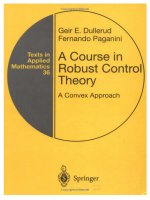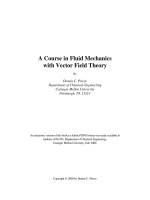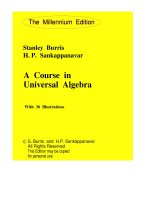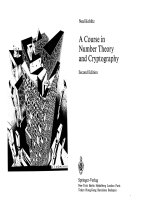2.a course in cryptography
Bạn đang xem bản rút gọn của tài liệu. Xem và tải ngay bản đầy đủ của tài liệu tại đây (1.69 MB, 204 trang )
a Course in
Cryptography
rafael pass
abhi shelat
c
2010 Pass/shelat
All rights reserved Printed online
11 11 11 11 11 15 14 13 12 11 10 9
First edition: June 2007
Second edition: September 2008
Third edition: January 2010
Contents
Contents i
Algorithms & Protocols v
List of Major Definitions vi
Preface vii
Numbering and Notation ix
1 Introduction 1
1.1 Classical Cryptography: Hidden Writing . . . . . 1
1.2 Modern Cryptography: Provable Security . . . . . 6
1.3 Shannon’s Treatment of Provable Secrecy . . . . . 10
1.4 Overview of the Course . . . . . . . . . . . . . . . 19
2 Computational Hardness 21
2.1 Efficient Computation and Efficient Adversaries . 21
2.2 One-Way Functions . . . . . . . . . . . . . . . . . . 26
2.3 Multiplication, Primes, and Factoring . . . . . . . 29
2.4 Hardness Amplification . . . . . . . . . . . . . . . 34
2.5 Collections of One-Way Functions . . . . . . . . . 41
2.6 Basic Computational Number Theory . . . . . . . 42
2.7 Factoring-based Collection of OWF . . . . . . . . . 51
2.8 Discrete Logarithm-based Collection . . . . . . . . 51
2.9 RSA Collection . . . . . . . . . . . . . . . . . . . . 53
2.10 One-way Permutations . . . . . . . . . . . . . . . . 55
2.11 Trapdoor Permutations . . . . . . . . . . . . . . . . 56
2.12 Rabin collection . . . . . . . . . . . . . . . . . . . . 57
i
ii CONTENTS
2.13 A Universal One Way Function . . . . . . . . . . . 63
3 Indistinguishability & Pseudo-Randomness 67
3.1 Computational Indistinguishability . . . . . . . . 68
3.2 Pseudo-randomness . . . . . . . . . . . . . . . . . 74
3.3 Pseudo-random generators . . . . . . . . . . . . . 77
3.4 Hard-Core Bits from Any OWF . . . . . . . . . . . 83
3.5 Secure Encryption . . . . . . . . . . . . . . . . . . . 91
3.6 An Encryption Scheme with Short Keys . . . . . . 92
3.7 Multi-message Secure Encryption . . . . . . . . . 93
3.8 Pseudorandom Functions . . . . . . . . . . . . . . 94
3.9 Construction of Multi-message Secure Encryption 99
3.10 Public Key Encryption . . . . . . . . . . . . . . . . 101
3.11 El-Gamal Public Key Encryption scheme . . . . . 105
3.12 A Note on Complexity Assumptions . . . . . . . . 107
4 Knowledge 109
4.1 When Does a Message Convey Knowledge . . . . 109
4.2 A Knowledge-Based Notion of Secure Encryption 110
4.3 Zero-Knowledge Interactions . . . . . . . . . . . . 113
4.4 Interactive Protocols . . . . . . . . . . . . . . . . . 114
4.5 Interactive Proofs . . . . . . . . . . . . . . . . . . . 116
4.6 Zero-Knowledge Proofs . . . . . . . . . . . . . . . 120
4.7 Zero-knowledge proofs for NP . . . . . . . . . . . 124
4.8 Proof of knowledge . . . . . . . . . . . . . . . . . . 130
4.9 Applications of Zero-knowledge . . . . . . . . . . 130
5 Authentication 133
5.1 Message Authentication . . . . . . . . . . . . . . . 133
5.2 Message Authentication Codes . . . . . . . . . . . 134
5.3 Digital Signature Schemes . . . . . . . . . . . . . . 135
5.4 A One-Time Signature Scheme for {0, 1}
n
. . . . . 136
5.5 Collision-Resistant Hash Functions . . . . . . . . . 139
5.6 A One-Time Digital Signature Scheme for {0, 1}
∗
144
5.7 *Signing Many Messages . . . . . . . . . . . . . . . 145
5.8 Constructing Efficient Digital Signature . . . . . . 148
5.9 Zero-knowledge Authentication . . . . . . . . . . 149
6 Computing on Secret Inputs 151
CONTENTS iii
6.1 Secret Sharing . . . . . . . . . . . . . . . . . . . . . 151
6.2 Yao Circuit Evaluation . . . . . . . . . . . . . . . . 154
6.3 Secure Computation . . . . . . . . . . . . . . . . . 164
7 Composability 167
7.1 Composition of Encryption Schemes . . . . . . . . 167
7.2 Composition of Zero-knowledge Proofs* . . . . . 175
7.3 Composition Beyond Zero-Knowledge Proofs . . 178
8 *More on Randomness and Pseudorandomness 179
8.1 A Negative Result for Learning . . . . . . . . . . . 179
8.2 Derandomization . . . . . . . . . . . . . . . . . . . 180
8.3 Imperfect Randomness and Extractors . . . . . . . 181
Bibliography 185
A Background Concepts 187
B Basic Complexity Classes 191
Algorithms & Protocols
2.3 A
( z): Breaking the factoring assumption . . . . . 33
2.4 A
( z
0
): Breaking the factoring assumption . . . . 37
2.4 A
0
( f , y) where y ∈
{
0, 1
}
n
. . . . . . . . . . . . . . 38
2.6 ExtendedEuclid(a, b) such that a > b > 0 . . . . . 43
2.6 ModularExponentiation(a, x, N) . . . . . . . . . . 45
2.6 Miller-Rabin Primality Test . . . . . . . . . . . . . 49
2.6 SamplePrime(n) . . . . . . . . . . . . . . . . . . . . 50
2.10 Adversary A
(N, e, y) . . . . . . . . . . . . . . . . . 55
2.12 Factoring Adversary A
(N) . . . . . . . . . . . . . 62
2.13 A Universal One-way Function f
universal
( y) . . . . 64
3.2 A
(1
n
, t
1
, . . . , t
i
): A next-bit predictor . . . . . . . . 76
3.4 DiscreteLog(g, p, y) using A . . . . . . . . . . . . . 84
3.4 B(y) . . . . . . . . . . . . . . . . . . . . . . . . . . . 88
3.4 B(y) for the General case . . . . . . . . . . . . . . 89
3.6 Encryption Scheme for n-bit message . . . . . . . 92
3.9 Many-message Encryption Scheme . . . . . . . . . 99
3.10 1-Bit Secure Public Key Encryption . . . . . . . . . 104
3.11 El-Gamal Secure Public Key Encryption . . . . . . 106
4.5 Protocol for Graph Non-Isomorphism . . . . . . . 118
4.5 Protocol for Graph Isomorphism . . . . . . . . . . 119
4.6 Simulator for Graph Isomorphism . . . . . . . . . 123
4.7 Zero-Knowledge for Graph 3-Coloring . . . . . . 127
4.7 Simulator for Graph 3-Coloring . . . . . . . . . . . 128
5.2 MAC Scheme . . . . . . . . . . . . . . . . . . . . . 134
5.4 One-Time Digital Signature Scheme . . . . . . . . 137
5.5 Collision Resistant Hash Function . . . . . . . . . 142
5.6 One-time Digital Signature for {0, 1}
∗
. . . . . . . 144
6.1 Shamir Secret Sharing Protocol . . . . . . . . . . . 154
v
6.2 A Special Encryption Scheme . . . . . . . . . . . . 157
6.2 Oblivious Transfer Protocol . . . . . . . . . . . . . 160
6.2 Honest-but-Curious Secure Computation . . . . . 162
7.1 π
: Many-message CCA2-secure Encryption . . . 169
7.2 ZK Protocol that is not Concurrently Secure . . . 176
List of Major Definitions
1.1 Private-key Encryption . . . . . . . . . . . . . . . . 3
1.3 Shannon secrecy . . . . . . . . . . . . . . . . . . . . 11
1.3 Perfect Secrecy . . . . . . . . . . . . . . . . . . . . . 11
2.1 Efficient Private-key Encryption . . . . . . . . . . 24
2.2 Worst-case One-way Function . . . . . . . . . . . . 26
2.5 Collection of OWFs . . . . . . . . . . . . . . . . . . 41
2.10 One-way permutation . . . . . . . . . . . . . . . . 55
2.11 Trapdoor Permutations . . . . . . . . . . . . . . . . 56
3.1 Computational Indistinguishability . . . . . . . . 69
3.2 Pseudo-random Ensembles . . . . . . . . . . . . . 74
3.3 Pseudo-random Generator . . . . . . . . . . . . . . 77
3.3 Hard-core Predicate . . . . . . . . . . . . . . . . . . 78
3.5 Secure Encryption . . . . . . . . . . . . . . . . . . . 91
3.7 Multi-message Secure Encryption . . . . . . . . . 93
3.8 Oracle Indistinguishability . . . . . . . . . . . . . . 96
3.8 Pseudo-random Function . . . . . . . . . . . . . . 96
3.10 Public Key Encryption Scheme . . . . . . . . . . . 102
3.10 Secure Public Key Encryption . . . . . . . . . . . . 102
4.2 Zero-Knowledge Encryption . . . . . . . . . . . . 111
4.5 Interactive Proof . . . . . . . . . . . . . . . . . . . . 116
4.5 Interactive Proof with Efficient Provers . . . . . . 119
4.7 Commitment . . . . . . . . . . . . . . . . . . . . . . 126
5.3 Security of Digital Signatures . . . . . . . . . . . . 136
6.2 Two-party Honest-but-Curious Secure Protocol . 155
vi
Preface
We would like to thank the students of CS 687 (Stephen Chong,
Michael Clarkson, Michael George, Lucja Kot, Vikram Krish-
naprasad, Huijia Lin, Jed Liu, Ashwin Machanavajjhala, Tudor
Marian, Thanh Nguyen, Ariel Rabkin, Tom Roeder, Wei-lung
Tseng, Muthuramakrishnan Venkitasubramaniam and Parvathi-
nathan Venkitasubramaniam) for scribing the original lecture
notes which served as a starting point for these notes. In particu-
lar, we are very grateful to Muthu for compiling these original
sets of notes.
Rafael Pass
Ithaca, NY
abhi shelat
Charlottesville, VA
August 2007
vii
Numbering and Notation
Numbering
Our definitions, theorems, lemmas, etc. are numbered as
X.y
where
X
is the page number on which the object has been defined
and
y
is a counter. This method should help you cross-reference
important mathematical statements in the book.
Notation
We use
N
to denote the set of natural numbers,
Z
to denote
the set of integers, and
Z
p
to denote the set of integers modulo
p
. The notation
[1, k]
denotes the set
{1, . . . , k}
. We often use
a = b mod n to denote modular congruency, i.e. a ≡ b (mod n).
Algorithms
Let
A
denote an algorithm. We write
A(·)
to denote an algo-
rithm with one input and
A(·, ·)
for two inputs. The output
of a (randomized) algorithm
A(·)
on input
x
is described by a
probability distribution which we denote by
A(x)
. An algorithm
is deterministic if the probability distribution is concentrated on a
single element.
Experiments
We denote by
x ← S
the experiment of sampling an element
x
from a probability distribution
S
. If
F
is a finite set, then
x ← F
denotes the experiment of sampling uniformly from the set
F
. We
use semicolon to describe the ordered sequences of event that
ix
x chapter 0. numbering and notation
make up an experiment, e.g.,
x ← S; (y, z) ← A(x)
Probabilities
If p( ., .) denotes a predicate, then
Pr[x ← S; (y, z) ← A(x) : p(y, z)]
is the probability that the predicate
p(y, z)
is true after the or-
dered sequence of events (x ← S; (y, z) ← A(x)). The notation
{x ← S; (y, z) ← A(x) : (y, z)}
denotes the probability distribution over
{y, z}
generated by
the experiment
(x ← S; (y, z) ← A(x))
. Following standard
notation,
Pr[A |B]
denotes the probability of event
A
conditioned on the event
B
.
When the
Pr[B] = 0
, then the conditional probability is not
defined. In this course, we slightly abuse notation in this case,
and define
Pr[A |B] = Pr[A] when Pr[B] = 0.
Big-O Notation
We denote by O(g(n)) the set of functions
{
f (n) : ∃c > 0, n
0
such that ∀n > n
0
, 0 ≤ f (n) ≤ cg(n)
}
.
Chapter 1
Introduction
The word cryptography stems from the two Greek words krypt
´
os
and gr
´
afein meaning “hidden” and “to write” respectively. In-
deed, the most basic cryptographic problem, which dates back
millenia, considers the task of using “hidden writing” to secure,
or conceal communication between two parties.
1.1 Classical Cryptography: Hidden Writing
Consider two parties, Alice and Bob. Alice wants to privately
send messages (called plaintexts) to Bob over an insecure channel.
By an insecure channel, we here refer to an “open” and tappable
channel; in particular, Alice and Bob would like their privacy to
be maintained even in face of an adversary Eve (for eavesdropper)
who listens to all messages sent on the channel. How can this be
achieved?
A possible solution
Before starting their communication, Alice
and Bob agree on a “secret code” that they will later use to
communicate. A secret code consists of a key, an algorithm
Enc
to encrypt (scramble) plaintext messages into ciphertexts and an
algorithm
Dec
to decrypt (or descramble) ciphertexts into plaintext
messages. Both the encryption and decryption algorithms require
the key to perform their task.
Alice can now use the key to encrypt a message, and then
send the ciphertext to Bob. Bob, upon receiving a ciphertext,
1
2 chapter 1. introduction
uses the key to decrypt the ciphertext and retrieve the original
message.
Alice Bob
Eve
Gen
c = Enc
k
(m) m = Dec
k
(c)
k
k
c
?
①
②
③
④
Figure 2.1: Illustration of the steps involved in private-key en-
cryption. First, a key
k
must be generated by the
Gen
algorithm
and privately given to Alice and Bob. In the picture, this is illus-
trated with a green “land-line.” Later, Alice encodes the message
m
into a ciphertext
c
and sends it over the insecure channel—in
this case, over the airwaves. Bob receives the encoded message
and decodes it using the key
k
to recover the original message
m
.
The eavesdropper Eve does not learn anything about
m
except
perhaps its length.
1.1.1 Private-Key Encryption
To formalize the above task, we must consider an additional
algorithm,
Gen
, called the key-generation algorithm; this algorithm
is executed by Alice and Bob to generate the key
k
which they
use to encrypt and decrypt messages.
A first question that needs to be addressed is what informa-
tion needs to be “public”—i.e., known to everyone—and what
needs to be “private”—i.e., kept secret. In historic approaches,
i.e. security by obscurity, all three algorithms,
(Gen, Enc, Dec )
, and
the generated key
k
were kept private; the idea was that the
less information we give to the adversary, the harder it is to
break the scheme. A design principle formulated by Kerchoff
1.1. Classical Cryptography: Hidden Writing 3
in 1884—known as Kerchoff’s principle—instead stipulates that
the only thing that one should assume to be private is the key
k
; everything else including
(Gen, Enc, Dec )
should be assumed
to be public. Why should we do this? Designs of encryption
algorithms are often eventually leaked, and when this happens
the effects to privacy could be disastrous. Suddenly the scheme
might be completely broken; this might even be the case if just a
part of the algorithm’s description is leaked. The more conser-
vative approach advocated by Kerchoff instead guarantees that
security is preserved even if everything but the key is known
to the adversary. Furthermore, if a publicly known encryption
scheme still has not been broken, this gives us more confidence
in its “true” security (rather than if only the few people that de-
signed it were unable to break it). As we will see later, Kerchoff’s
principle will be the first step to formally defining the security of
encryption schemes.
Note that an immediate consequence of Kerchoff’s principle is
that all of the algorithms
(Gen, Enc, Dec )
can not be deterministic;
if this were so, then Eve would be able to compute everything
that Alice and Bob could compute and would thus be able to
decrypt anything that Bob can decrypt. In particular, to prevent
this we must require the key generation algorithm,
Gen
, to be
randomized.
Definition 3.2
(Private-key Encryption). The triplet of algorithms
(Gen, Enc, Dec )
is called a private-key encryption scheme over the
message space M and the keyspace K if the following holds:
1. Gen
(called the key generation algorithm) is a randomized
algorithm that returns a key
k
such that
k ∈ K
. We denote
by k ← Gen the process of generating a key k.
2. Enc
(called the encryption algorithm) is a potentially random-
ized algorithm that on input a key
k ∈ K
and a message
m ∈ M
, outputs a ciphertext
c
. We denote by
c ← Enc
k
( m)
the output of Enc on input key k and message m.
3. Dec
(called the decryption algorithm) is a deterministic algo-
rithm that on input a key
k
and a ciphertext
c
outputs a
message m ∈ M ∪⊥.
4 chapter 1. introduction
4. For all m ∈ M,
Pr[k ← Gen : Dec
k
(Enc
k
( m)) = m] = 1
To simplify notation we also say that
( M, K, Gen, Enc, Dec)
is a
private-key encryption scheme if
(Gen, Enc, Dec )
is a private-key
encryption scheme over the messages space
M
and the keyspace
K
. To simplify further, we sometimes say that
( M, Gen, Enc, Dec)
is a private-key encryption scheme if there exists some key space
K
such that
( M, K, Gen, Enc, Dec)
is a private-key encryption
scheme.
Note that the above definition of a private-key encryption
scheme does not specify any secrecy (or privacy) properties; the
only non-trivial requirement is that the decryption algorithm
Dec
uniquely recovers the messages encrypted using
Enc
(if these
algorithms are run on input with the same key
k ∈ K
). Later,
we will return to the task of defining secrecy. However, first, let
us provide some historical examples of private-key encryption
schemes and colloquially discuss their “security” without any
particular definition of secrecy in mind.
1.1.2 Some Historical Ciphers
The Caesar Cipher (named after Julius Ceasar who used it to
communicate with his generals) is one of the simplest and well-
known private-key encryption schemes. The encryption method
consist of replacing each letter in the message with one that is a
fixed number of places down the alphabet. More precisely,
Definition 4.3 The Ceasar Cipher is defined as follows:
M = {A, B, . . . , Z}
∗
K = {0, 1, 2, . . . , 25}
Gen = k where k
r
← K.
Enc
k
m
1
m
2
. . .m
n
= c
1
c
2
. . .c
n
where c
i
= m
i
+ k mod 26
Dec
k
c
1
c
2
. . .c
n
= m
1
m
2
. . .m
n
where m
i
= c
i
−k mod 26
In other words, encryption is a cyclic shift of
k
on each letter in
the message and the decryption is a cyclic shift of
−k
. We leave
it for the reader to verify the following proposition.
1.1. Classical Cryptography: Hidden Writing 5
Proposition 5.4 Caesar Cipher is a private-key encryption scheme.
At first glance, messages encrypted using the Ceasar Cipher
look “scrambled” (unless
k
is known). However, to break the
scheme we just need to try all 26 different values of
k
(which is
easily done) and see if the resulting plaintext is “readable”. If
the message is relatively long, the scheme is easily broken. To
prevent this simple brute-force attack, let us modify the scheme.
In the improved Substitution Cipher we replace letters in the
message based on an arbitrary permutation over the alphabet
(and not just cyclic shifts as in the Caesar Cipher).
Definition 5.5 The Subsitution Cipher is defined as follows:
M = {A, B, . . . , Z}
∗
K = the set of permutations of {A, B, . . . , Z}
Gen = k where k
r
← K.
Enc
k
( m
1
. . .m
n
) = c
1
. . .c
n
where c
i
= k(m
i
)
Dec
k
( c
1
c
2
. . .c
n
) = m
1
m
2
. . .m
n
where m
i
= k
−1
( c
i
)
Proposition 5.6
The Subsitution Cipher is a private-key encryption
scheme.
To attack the substitution cipher we can no longer perform the
brute-force attack because there are now
26!
possible keys. How-
ever, if the encrypted message is sufficiently long, the key can
still be recovered by performing a careful frequency analysis of
the alphabet in the English language.
So what do we do next? Try to patch the scheme again?
Indeed, cryptography historically progressed according to the
following “crypto-cycle”:
1. A, the “artist”, invents an encryption scheme.
2. A
claims (or even mathematically proves) that known attacks
do not work.
3.
The encryption scheme gets employed widely (often in
critical situations).
4. The scheme eventually gets broken by improved attacks.
6 chapter 1. introduction
5.
Restart, usually with a patch to prevent the previous attack.
Thus, historically, the main job of a cryptographer was crypto-
analysis—namely, trying to break an encryption scheme. Cryp-
toanalysis is still an important field of research; however, the
philosophy of modern theoretical cryptography is instead “if
we can do the cryptography part right, there is no need for
cryptanalysis”.
1.2 Modern Cryptography: Provable Security
Modern Cryptography is the transition from cryptography as
an art to cryptography as a principle-driven science. Instead of
inventing ingenious ad-hoc schemes, modern cryptography relies
on the following paradigms:
— Providing mathematical definitions of security.
—
Providing precise mathematical assumptions (e.g. “factoring is
hard”, where hard is formally defined). These can be viewed
as axioms.
—
Providing proofs of security, i.e., proving that, if some particu-
lar scheme can be broken, then it contradicts an assumption
(or axiom). In other words, if the assumptions were true,
the scheme cannot be broken.
This is the approach that we develop in this course.
As we shall see, despite its conservative nature, we will suc-
ceed in obtaining solutions to paradoxical problems that reach
far beyond the original problem of secure communication.
1.2.1 Beyond Secure Communication
In the original motivating problem of secure communication, we
had two honest parties, Alice and Bob and a malicious eaves-
dropper Eve. Suppose, Alice and Bob in fact do not trust each
other but wish to perform some joint computation. For instance,
Alice and Bob each have a (private) list and wish to find the
intersection of the two list without revealing anything else about
1.2. Modern Cryptography: Provable Security 7
the contents of their lists. Such a situation arises, for example,
when two large financial institutions which to determine their
“common risk exposure,” but wish to do so without revealing
anything else about their investments. One good solution would
be to have a trusted center that does the computation and reveals
only the answer to both parties. But, would either bank trust
the “trusted” center with their sensitive information? Using tech-
niques from modern cryptography, a solution can be provided
without a trusted party. In fact, the above problem is a special
case of what is known as secure two-party computation.
Secure two-party computation - informal definition:
A secure
two-party computation allows two parties
A
and
B
with private
inputs
a
and
b
respectively, to compute a function
f (a, b)
that op-
erates on joint inputs
a, b
while guaranteeing the same correctness
and privacy as if a trusted party had performed the computation
for them, even if either
A
or
B
try to deviate from the proscribed
computation in malicious ways.
Under certain number theoretic assumptions (such as “fac-
toring is hard”), there exists a protocol for secure two-party
computation.
The above problem can be generalized also to situations with
multiple distrustful parties. For instance, consider the task of
electronic elections: a set of
n
parties which to perform an election
in which it is guaranteed that all votes are correctly counted, but
each vote should at the same time remain private. Using a so
called multi-party computation protocol, this task can be achieved.
A toy example: The match-making game
To illustrate the notion of secure-two party computation we
provide a “toy-example” of a secure computation using physical
cards. Alice and Bob want to find out if they are meant for
each other. Each of them have two choices: either they love the
other person or they do not. Now, they wish to perform some
interaction that allows them to determine whether there is a
match (i.e., if they both love each other) or not—and nothing
more. For instance, if Bob loves Alice, but Alice does not love
him back, Bob does not want to reveal to Alice that he loves
8 chapter 1. introduction
her (revealing this could change his future chances of making
Alice love him). Stating it formally, if love and no-love were the
inputs and match and no-match were the outputs, the function
they want to compute is:
f (love, love) = match
f (love, no-love) = no-match
f (no-love, love) = no-match
f (no-love, no-love) = no-match
Note that the function f is simply an and gate.
The protocol:
Assume that Alice and Bob have access to five
cards, three identical hearts(
♥
) and two identical clubs(
♣
). Alice
and Bob each get one heart and one club and the remaining heart
is put on the table face-down.
Next Alice and Bob also place their cards on the table, also
turned over. Alice places her two cards on the left of the heart
which is already on the table, and Bob places his two cards on
the right of the heart. The order in which Alice and Bob place
their two cards depends on their input as follows. If Alice loves,
then Alice places her cards as
♣♥
; otherwise she places them as
♥♣
. Bob on the other hand places his card in the opposite order:
if he loves, he places
♥♣
, and otherwise places
♣♥
. These orders
are illustrated in Fig. 1.
When all cards have been placed on the table, the cards are
piled up. Alice and Bob then each take turns to privately cut the
pile of cards once each so that the other person does not see how
the cut is made. Finally, all cards are revealed. If there are three
hearts in a row then there is a match and no-match otherwise.
Analyzing the protocol:
We proceed to analyze the above pro-
tocol. Given inputs for Alice and Bob, the configuration of cards
on the table before the cuts is described in Fig. 2. Only the first
case—i.e.,
(love, love)
—results in three hearts in a row. Further-
more this property is not changed by the cyclic shift induced by
the cuts made by Alice and Bob. We conclude that the protocols
correctly computes the desired function.
1.2. Modern Cryptography: Provable Security 9
♥♣
♥
♣♥ ♥♣
♣♥
Alice Bob
love
love
no-love
inputs inputs
no-love
Figure 9.1: Illustration of the Match game with Cards
♣♥♥♥♣
♥♣♥♣♥
love, love
no-love, love
♥♣♥♥♣
love, no-love
no-love, no-love
♣♥♥♣♥
cyclic shifts
}
Figure 9.2: The possible outcomes of the Match Protocol. In case
of a mismatch, all three outcomes are cyclic shifts of one-another.
In the remaining three cases (when the protocol outputs
no-match), all the above configurations are cyclic shifts of one
another. If one of Alice and Bob is honest—and indeed per-
forms a random cut—the final card configuration is identically
distributed no matter which of the three initial cases we started
from. Thus, even if one of Alice and Bob tries to deviate in the
protocol (by not performing a random cut), the privacy of the
other party is still maintained.
Zero-knowledge proofs
Zero knowledge proofs is a special case of a secure computation.
Informally, in a Zero Knowledge Proof there are two parties,
Alice and Bob. Alice wants to convince Bob that some statement
10 chapter 1. introduction
is true; for instance, Alice wants to convince Bob that a number
N
is a product of two primes
p, q
. A trivial solution would be for
Alice to send
p
and
q
to Bob. Bob can then check that
p
and
q
are
primes (we will see later in the course how this can be done) and
next multiply the numbers to check if their product is
N
. But this
solution reveals
p
and
q
. Is this necessary? It turns out that the
answer is no. Using a zero-knowledge proof Alice can convince
Bob of this statement without revealing the factors p and q.
1.3 Shannon’s Treatment of Provable Secrecy
Modern (provable) cryptography started when Claude Shannon
formalized the notion of private-key encryption. Thus, let us re-
turn to our original problem of securing communication between
Alice and Bob.
1.3.1 Shannon Secrecy
As a first attempt, we might consider the following notion of
security:
The adversary cannot learn (all or part of) the key
from the ciphertext.
The problem, however, is that such a notion does not make any
guarantees about what the adversary can learn about the plaintext
message. Another approach might be:
The adversary cannot learn (all, part of, any letter of,
any function of, or any partial information about) the
plaintext.
This seems like quite a strong notion. In fact, it is too strong
because the adversary may already possess some partial infor-
mation about the plaintext that is acceptable to reveal. Informed
by these attempts, we take as our intuitive definition of security:
Given some a priori information, the adversary cannot
learn any additional information about the plaintext
by observing the ciphertext.
1.3. Shannon’s Treatment of Provable Secrecy 11
Such a notion of secrecy was formalized by Claude Shannon in
1949 [
sha49
] in his seminal paper that started the modern study
of cryptography.
Definition 11.1
(Shannon secrecy).
( M, K, Gen, Enc, Dec)
is said
to be a private-key encryption scheme that is Shannon-secret with
respect to the distibution
D
over the message space
M
if for all
m
∈ M and for all c,
Pr
k ← Gen; m ← D : m = m
|Enc
k
( m) = c
= Pr
m ← D : m = m
.
An encryption scheme is said to be Shannon secret if it is Shannon
secret with respect to all distributions D over M.
The probability is taken with respect to the random output of
Gen
, the choice of
m
and the random coins used by algorithm
Enc
. The quantity on the left represents the adversary’s a poste-
riori distribution on plaintexts after observing a ciphertext; the
quantity on the right, the a priori distribution. Since these distri-
butions are required to be equal, this definition requires that the
adversary does not gain any additional information by observing
the ciphertext.
1.3.2 Perfect Secrecy
To gain confidence that our definition is the right one, we also pro-
vide an alternative approach to defining security of encryption
schemes. The notion of perfect secrecy requires that the distri-
bution of ciphertexts for any two messages are identical. This
formalizes our intuition that the ciphertexts carry no information
about the plaintext.
Definition 11.2
(Perfect Secrecy). A tuple
( M, K, Gen, Enc, Dec)
is said to be a private-key encryption scheme that is perfectly
secret if for all m
1
and m
2
in M, and for all c,
Pr[k ← Gen : Enc
k
( m
1
) = c] = Pr[k ← Gen : Enc
k
( m
2
) = c].
12 chapter 1. introduction
Notice that perfect secrecy seems like a simpler notion. There is
no mention of “a-priori” information, and therefore no need to
specify a distribution over the message space. Similarly, there is
no conditioning on the ciphertext. The definition simply requires
that for every pair of messages, the probabilities that either mes-
sage maps to a given ciphertext
c
must be equal. Perfect security
is syntactically simpler than Shannon security, and thus easier to
work with. Fortunately, as the following theorem demonstrates,
Shannon Secrecy and Perfect Secrecy are equivalent notions.
Theorem 12.3
A private-key encryption scheme is perfectly secret if
and only if it is Shannon secret.
Proof. We prove each implication separately. To simplify the
notation, we introduce the following abbreviations. Let
Pr
k
[
···
]
denote
Pr
[
k ← Gen; ···
]
,
Pr
m
[
···
]
denote
Pr
[
m ← D : ···
]
, and
Pr
k,m
[
···
]
denote Pr
[
k ← Gen; m ← D : ···
]
.
Perfect secrecy implies Shannon secrecy.
The intuition is that
if, for any two pairs of messages, the probability that either of
messages encrypts to a given ciphertext must be equal, then it
is also true for the pair
m
and
m
in the definition of Shannon
secrecy. Thus, the ciphertext does not “leak” any information,
and the a-priori and a-posteriori information about the message
must be equal.
Suppose the scheme
( M, K, Gen, Enc, Dec)
is perfectly secret.
Consider any distribution
D
over
M
, any message
m
∈ M
, and
any ciphertext c. We show that
Pr
k,m
m = m
| Enc
k
( m) = c
= Pr
m
m = m
.
By the definition of conditional probabilities, the left hand side
of the above equation can be rewritten as
Pr
k,m
[
m = m
∩Enc
k
( m) = c
]
Pr
k,m
[
Enc
k
( m) = c
]
which can be re-written as
Pr
k,m
[
m = m
∩Enc
k
( m
) = c
]
Pr
k,m
[
Enc
k
( m) = c
]
1.3. Shannon’s Treatment of Provable Secrecy 13
and expanded to
Pr
m
[
m = m
]
Pr
k
[
Enc
k
( m
) = c
]
Pr
k,m
[
Enc
k
( m) = c
]
The central idea behind the proof is to show that
Pr
k,m
[
Enc
k
( m) = c
]
= Pr
k
Enc
k
( m
) = c
which establishes the result. To begin, rewrite the left-hand side:
Pr
k,m
[
Enc
k
( m) = c
]
=
∑
m
∈M
Pr
m
m = m
Pr
k
Enc
k
( m
) = c
By perfect secrecy, the last term can be replaced to get:
∑
m
∈M
Pr
m
m = m
Pr
k
Enc
k
( m
) = c
This last term can now be moved out of the summation and
simplified as:
Pr
k
Enc
k
( m
) = c
∑
m
∈M
Pr
m
m = m
= Pr
k
Enc
k
( m
) = c
.
Shannon secrecy implies perfect secrecy.
In this case, the in-
tuition is Shannon secrecy holds for all distributions
D
; thus,
it must also hold for the special cases when
D
only chooses
between two given messages.
Suppose the scheme
( M, K, Gen, Enc, Dec)
is Shannon-secret.
Consider
m
1
, m
2
∈ M
, and any ciphertext
c
. Let
D
be the uniform
distribution over {m
1
, m
2
}. We show that
Pr
k
[
Enc
k
( m
1
) = c
]
= Pr
k
[
Enc
k
( m
2
) = c
]
.
The definition of
D
implies that
Pr
m
[
m = m
1
]
= Pr
m
[
m = m
2
]
=
1
2
. It therefore follows by Shannon secrecy that
Pr
k,m
[
m = m
1
| Enc
k
( m) = c
]
= Pr
k,m
[
m = m
2
| Enc
k
( m) = c
]









